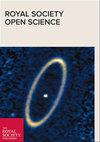身体庞大、不会飞的鼠类(鸟类:古鸟类)的大脑形状是通过不同的发育异构体形成的。
IF 2.9
3区 综合性期刊
Q1 MULTIDISCIPLINARY SCIENCES
引用次数: 0
摘要
长期以来,比较神经解剖学研究一直在争论发育在新型和不同大脑形态进化中的作用。从历史上看,这些研究强调的是,沿着保守或独特的发育异速趋势的进化转变是否会导致大脑形态的变化。然而,大小不一的类群之间的种间差异在多大程度上是通过改变发育异构而产生的,这一点在很大程度上仍未得到验证。因此,具有不同大脑形状和大小的类群有助于研究发育趋势如何导致神经解剖学的多样化。在这里,我们研究了大体型鼠类鸟类(约 60-140 千克)的发育系列。我们对普通鸵鸟、鸸鹋和南方食火鸡的头骨内骨进行了三维几何形态计量学研究,并将它们的发育轨迹与体型较小的家鸡的发育轨迹进行了比较。结果表明,鼠类和鸡表现出不同的颅内形状,这并不能简单地用它们的体型差异来解释。当对形状和年龄进行研究时,鸡的部分大脑形状比体型和年龄相似的鼠类大脑形状更快、更成熟。总之,我们的研究表明,这些大小不同的类群之间不同的大脑形状是由不同的发育异构进化而来的,而不是简单地遵循保守的缩放趋势。本文章由计算机程序翻译,如有差异,请以英文原文为准。
Brain shapes of large-bodied, flightless ratites (Aves: Palaeognathae) emerge through distinct developmental allometries.
Comparative neuroanatomical studies have long debated the role of development in the evolution of novel and disparate brain morphologies. Historically, these studies have emphasized whether evolutionary shifts along conserved or distinct developmental allometric trends cause changes in brain morphologies. However, the degree to which interspecific differences between variably sized taxa originate through modifying developmental allometry remains largely untested. Taxa with disparate brain shapes and sizes thus allow for investigation into how developmental trends contribute to neuroanatomical diversification. Here, we examine a developmental series of large-bodied ratite birds (approx. 60-140 kg). We use three-dimensional geometric morphometrics on cephalic endocasts of common ostriches, emus and southern cassowaries and compare their developmental trajectories with those of the more modestly sized domestic chicken, previously shown to be in the same allometric grade as ratites. The results suggest that ratites and chickens exhibit disparate endocranial shapes not simply accounted for by their size differences. When shape and age are examined, chickens partly exhibit more accelerated and mature brain shapes than ratites of similar size and age. Taken together, our study indicates that disparate brain shapes between these differently sized taxa have emerged from the evolution of distinct developmental allometries, rather than simply following conserved scaling trends.
求助全文
通过发布文献求助,成功后即可免费获取论文全文。
去求助
来源期刊

Royal Society Open Science
Multidisciplinary-Multidisciplinary
CiteScore
6.00
自引率
0.00%
发文量
508
审稿时长
14 weeks
期刊介绍:
Royal Society Open Science is a new open journal publishing high-quality original research across the entire range of science on the basis of objective peer-review.
The journal covers the entire range of science and mathematics and will allow the Society to publish all the high-quality work it receives without the usual restrictions on scope, length or impact.
 求助内容:
求助内容: 应助结果提醒方式:
应助结果提醒方式:


